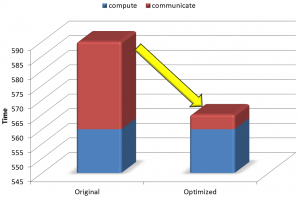(See the prelude for some general information on what this is all about)
Have you ever thought about how to improve the aerodynamic properties of bulldozers? Yes? Then this stunt is for you.
Code optimization is quite rewarding at times. You put all your effort into mutilating a chunk of code beyond all recognition, and in the end you get a 50% speedup. Often enough, this work requires a great deal of expertise at the interface between hardware and software. And you certainly want to present your success to your peers so they understand how advanced you are.
If you do such a thing, don’t bother picking the low-hanging fruits. When 95% of the run time goes into a boring loop nest which multiplies a dense matrix with a vector, there is not much you can do beyond the standard textbook stuff – or use a library altogether. However, if the remaining 5% consist of a convoluted communication scheme, you’ve found your target. The fact that the possible gain is at most 5% shouldn’t stop you, because it’s all a matter of presentation; see Fig. 1: 3D bars and a proper choice of scales on the axes guide the reader’s eye and help you drive home your point. It’s like presenting the optimized drag coefficient of your aerodynamically improved bulldozer on high gloss paper, and the boring technical data in small black print on a dark blue background, on the back page.
Interestingly, if the optimization target is communication, or synchronization, or any other non-computational overhead, this stunt can be made to work even better: When you strongly scale to a pointless number of workers, reducing such overheads will give you arbitrary speedups, far beyond the factor of two that is theoretically possible if you restrict yourself to a sensible minimum parallel efficiency of 50%. Coming back to the heavy gear analogy, if you accelerate your bulldozer to 200 mph, the drag coefficient does become essential, and you may feel vindicated. It won’t solve any real-world problem, but hey, this is research after all.
Thanks to Gerhard Wellein for discovering this stunt in a paper. Many papers, actually.
